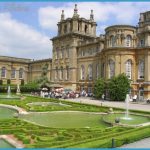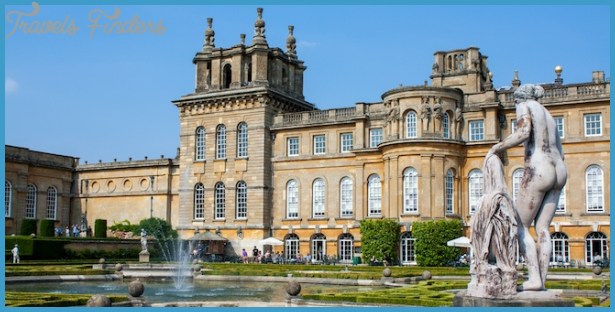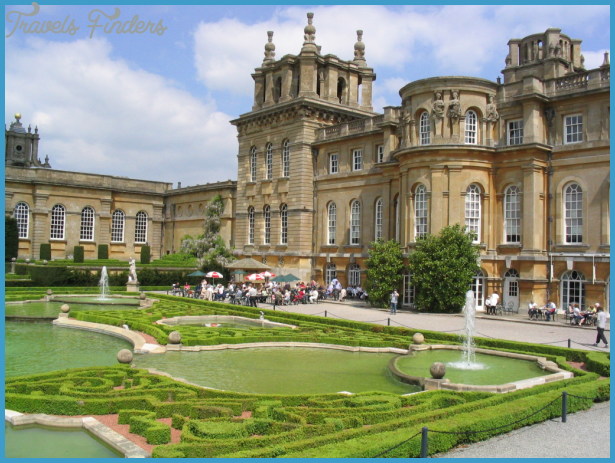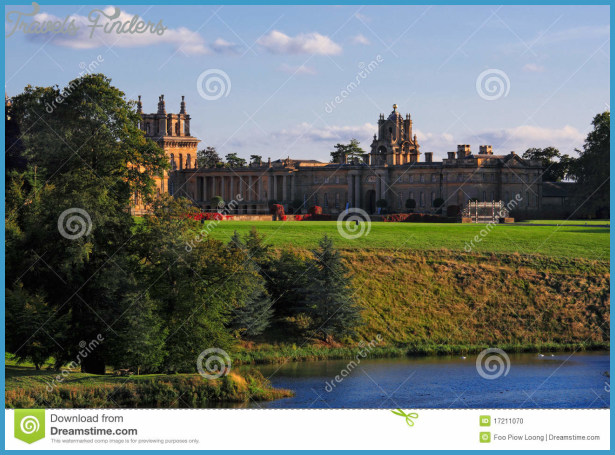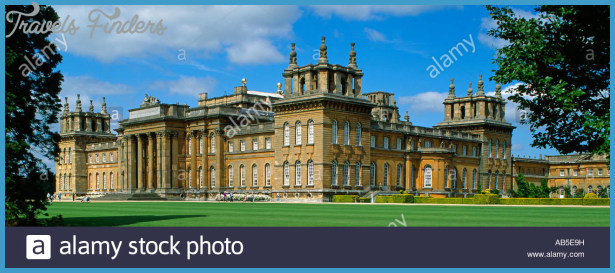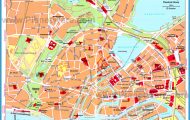JOHN VANBRUGH
Buildings a stable block and a kitchen wing-each laid out around its own courtyard and each larger than many country houses.
The style used by Vanbrugh for this enormous house was his own personal version of Baroque. In mainland Europe, Baroque buildings are often typified by a blend of intricately curving walls and highly ornate decoration that creates a feeling of lightness. Vanbrugh’s style, which he developed with his assistant, Nicholas Hawksmoor, is far more ponderous. Blenheim combines classical features, such as a large central portico, with heavy, elaborate details that are more Baroque in style-monumental arches, heavily banded masonry, and an abundance
John, 1st Duke of Marlborough, was a British military hero who won a major victory at the Battle of Blenheim in Bavaria in 1704 during the War of the Spanish Succession. As a reward Queen Anne, the British monarch, offered to build a vast country house for him and his wife Sarah. Sir John Vanbrugh was chosen as architect and rose to the challenge by designing one of the grandest houses in Europe, a building on a staggering scale designed to rival Louis XIV’s palace at Versailles (see pp.146-51). Blenheim soon became known as a palace itself. Like Versailles it is set around a huge courtyard with the residential apartments in the center. Flanking this section are two additional of statues. The massive scale and symmetrical layout of Blenheim create an overwhelming impression of grandeur, accentuated by the dramatic silhouette produced by the gigantic chimneys and exaggerated finials.
The symmetry of the palace’s exterior is replicated inside. Vanbrugh designed the interior in a formal manner, as was customary at the time. In the middle of the central block are two lofty double-height rooms, the Great Hall and the Saloon, a state dining room. On either side of the Saloon, along the south front, are two matching suites of large staterooms for important guests, such as the monarch and consort. In each suite the largest, most public chamber adjoins the central Saloon, and the smaller, more private rooms stretch out on either side. On the east front there is a similar but smaller pair of suites, also symmetrical in layout, for the Duke and Duchess. More modest rooms, corridors, and staircases run behind them. Because the 18th-century custom of using suites went out of fashion, many of these rooms are now furnished differently, but their magnificent proportions and some of their lavish decorative schemes have been preserved.
JOHN VANBRUGH
1664-1726
Born in London, John Vanbrugh had both English and Dutch ancestors. In his 20s he was an army officer and participated in the political maneuvers that led to the accession of a Dutch king, William III, to the English throne in 1689. In the 1690s he became a dramatist, writing many comedies, of which The Relapse and The Provoked Wife are the most famous. At the end of the decade, apparently without any training, he began to design buildings, becoming especially successful as an architect of country houses.
Some, including Castle Howard, Seaton Delaval Hall, and Blenheim, were on a vast scale. Although Vanbrugh undoubtedly learned from theatrical design, it is unlikely that he would have been able to achieve these grand and complex buildings without professional help. He was fortunate to work with Nicholas Hawksmoor, an architect who had learned his art with Sir Christopher Wren and designed many churches and houses in the Baroque style. No one knows for sure how the two men worked together
Vanbrugh may have drawn up the plans and left the details to Hawksmoor, but Vanbrugh is credited with the grandiose conception of these palatial country houses, and of smaller buildings that display the same dramatic Baroque style.
Visual tour: exterior
4 EAST FACADE Vanbrugh created the most dramatic impression using standard architectural features windows, cornices, walls, and chimneys. The main windows are tall and round-topped, which gives them a grandeur that rectangular windows lack. The walls of the corner towers have banded masonry and look monumental. The real drama, however, is at the tops of the towers. Above the projecting cornice is a cluster of turrets and chimneys, linked by small arches. Bulbous finials at the top of the four corner turrets create a bizarre skyline.
1 SOUTH FRONT Two corner towers balance the ends of the south front, but the architecture draws your eye toward the center of the building.
Here, a row of tall columns known as a giant order rises the full height of the two main stories. This marks the central portion of the building as the most important. Behind the doorway is the Saloon and beyond it the Great Hall, which, like the giant order, is two stories high. The fagade is perfectly symmetrical, and on either side of the saloon is a series of equally symmetrical rooms, mirroring the poise and balance of the fagade.
4 COLUMN DETAIL Although Vanbrugh always strove for large-scale effects, the small details were carefully worked out too. This view of the top of one of the Corinthian columns that supports the pediment on the north front is an example. The carving of the capital, with its curling acanthus leaves, is rich and deep. The pediment above it is also copiously carved. Each of the dentils, the small repeating blocks along the base of the pediment, has a tiny rosette, and even the spaces between the dentils are decorated, as are many of the moldings.
3 HERMS Female statues line the upper level of one of the semicircular bays that protrude from the palace fagades. These statues are herms, a form from ancient Greek sculpture in which a human head or torso is mounted on a plain base.
Ancient herms were usually male, but at Blenheim the herms are female, giving the sculptor the chance to carve the rich drapery of their costumes in flowing Baroque knots and folds.
IN CONTEXT
Blenheim is set in a large park, and work on laying this out began at the same time as the building. Marlborough’s gardener, Henry Wise, designed formal gardens close to the house, with symmetrical flowerbeds making intricate patterns separated by low hedges. Farther from the house Vanbrugh created a bridge to form part of an approach route across the marshy valley of the River Glyme. Later in the 18th century fashions changed, and the duke of the time brought in the great landscape gardener Lancelot Capability Brown to redesign the park in a less formal style. Brown created a natural-looking landscape, with clumps of trees, vistas, and a lake in the valley making two great curves on either side of Vanbrugh’s bridge. Today the gardens are a creative compromise between these two styles. Formal gardens near the house have been restored, with flowerbeds, statuary, and fountains installed in the 1920s, but Brown’s natural-looking park, with its trees and lake, remains as a fitting landscape setting.
1 Grand Bridge
Vanbrugh’s bridge originally crossed a river but is now partially submerged in Capability Brown’s lake.
ON DESIGN
From the very first stage of design it was clear that Blenheim Palace was intended to be a house fit for a hero, a man who, in the words of Marlborough’s descendant Sir Winston Churchill, had, through his military victories, changed the axis of the world. The palace is heroic in scale, as it is in the symbolism of many of its details. At several points on the building there are sculptures representing weapons, flags, drums, and other spoils of war. Military symbols were an ancient theme in sculpture and were especially popular in the Renaissance to indicate that the person who owned or commissioned the sculpture was a war hero or had been successful in battle.
4 ENTRANCE ARCH The clock tower rises above an entrance arch to one of Blenheim’s courtyards. Vanbrugh’s treatment of the masonry and details adds to the sense of grandeur. One example is the choice of keystone, the wedge-shaped stone at the top of the arch. This is normally sizable, but here it is three or four times the size of the stones on either side of it, giving a sense of enormous weight.
The design of the semicircular window varies this approach. There is another large keystone, this time flanked by two pairs of blocks that are almost as big. The columns on either side of the arch work in a similar way. Their banded masonry makes them look as if they are composed of huge stone blocks. This is an illusion, because each band consists of two or three blocks, discreetly joined. The architect and builders worked closely together to produce these theatrical effects.
1 Triumphal sculpture
This carved collection of arms, armor, and flags is at the top of the building so it stands out defiantly on the skyline.
Visual tour: interior
4 GREEN WRITING ROOM This room, which has a ceiling with rich gilded decoration, pale paneling on the walls, and paneled doors, is most notable for its furnishings. Chief among these is the tapestry, which was specially commissioned for the palace and spans one corner of the room. It shows the Duke of Marlborough on horseback, accepting the surrender of the French leader Marshall Tallard after the Battle of Blenheim. The details, which include burning buildings in the distance and French troops fleeing toward the Danube River, are realistic and probably based on the Duke’s memories of the event.
3 GREAT HALL This is the largest room in the Palace and is some 67ft (20m) high. It combines the roles of entrance hall and reception room and gives access to the long corridors that lead to the other principal rooms. The Great Hall is lined with stone arches, and their sculpture, including the Corinthian capitals and the coat of arms of Queen Anne in the center of the large arch, are by Grinling Gibbons, the greatest carver of the period. The enormous arch at the end of the room is a typical Vanbrugh touch and was probably meant to remind visitors of Roman triumphal arches.
3 SALOON This large room is furnished as a state dining room. Vanbrugh wanted Sir James Thornhill to paint the walls and ceiling, but Marlborough’s wife Sarah contended that the artist had overcharged for the ceiling in the Great Hall. A French painter, Louis Laguerre, did the job instead. Laguerre depicts the nations of the world around the walls and the Duke of Marlborough in a victory procession on the ceiling.
1 RED DRAWING ROOM Taking its name from its red damask wall covering, the Red Drawing Room is typical of the reception rooms on the south front of the Palace. It owes its appearance to more than one period. The shape of the room, with its high, coved ceiling, is original, and the ceiling design probably stems from Vanbrugh’s assistant, Nicholas Hawksmoor, but the room was altered later in the 18th century, when the architect Sir William Chambers was brought in to redecorate parts of the building. Chambers designed the fireplace in the elegant neoclassical style of the 1760s.
2 LONG LIBRARY This huge, double-height room runs along the entire west front of the building and is 183ft (56m) long. Vanbrugh and Hawksmoor originally planned it as what they called a room of parade. The occupants of the house would be able to walk up and down and admire the collection of pictures on the walls, as they did in similar long galleries in Tudor country houses. The architects broke up the space by dividing it with arches and treating the ceiling as a sequence of rectangles and circles, which look like shallow domes. Thornhill was originally going to paint the ceiling, but because Sarah objected to the artist’s fees, it was left blank. In 1744 the room became a library, and its shelves hold around 10,000 volumes.


